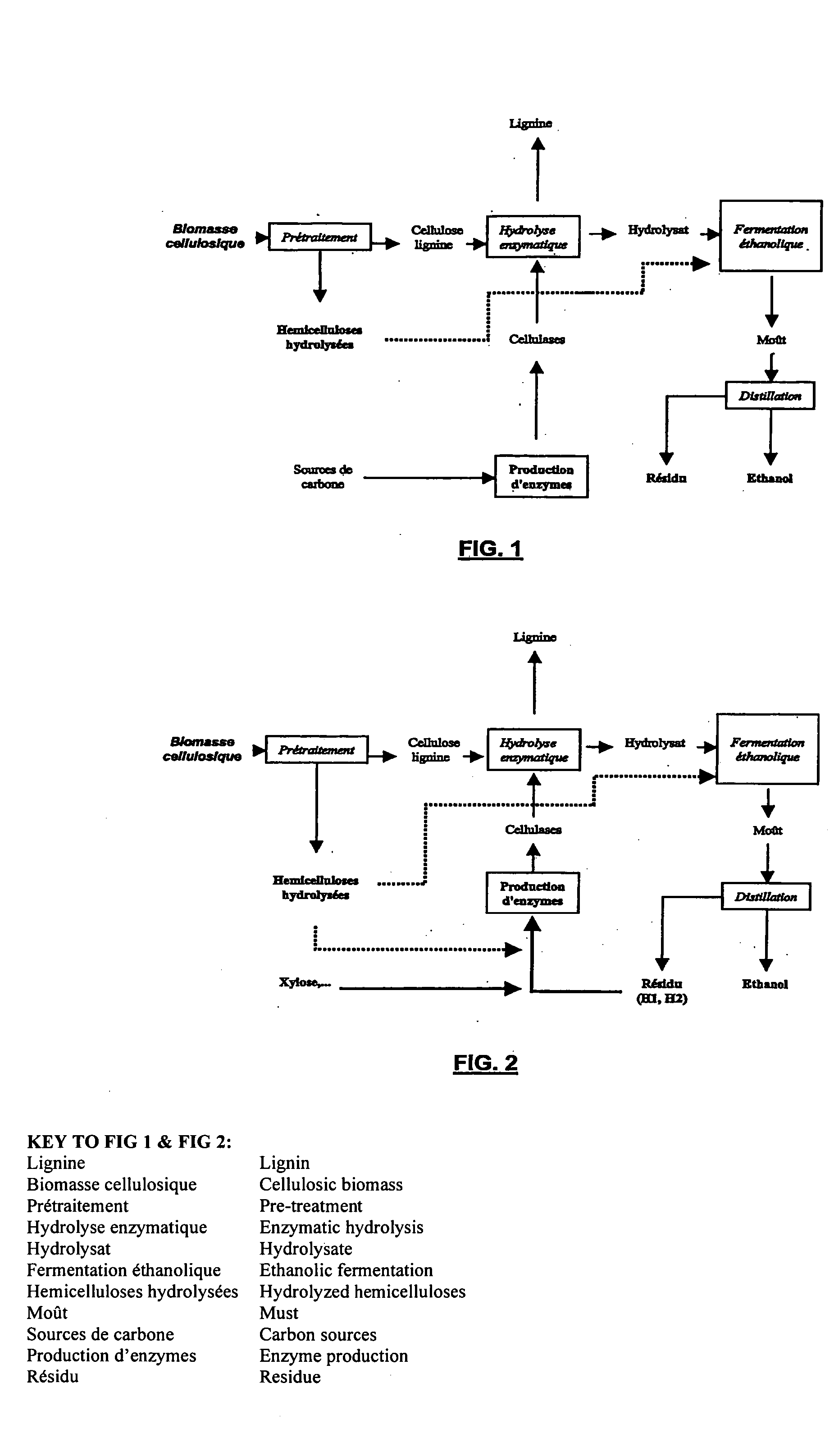Process for the production of cellulolytic and hemicellulolytic enzymes using distillation residues from the ethanolic fermentation of enzymatic hydrolyzates of (ligno)cellulosic materials
- Summary
- Abstract
- Description
- Claims
- Application Information
AI Technical Summary
Problems solved by technology
Method used
Image
Examples
example 1
Production of Enzymes on Lactose
[0036] The production of cellulases was carried out in a mechanically stirred fermenter. The medium had the following composition: KOH, 1.66 g / l; 85% H3PO4, 2 ml / l; (NH4)SO4, 2.8 g / l; MgSO4,7H2O, 0.6 g / l; CaCl2, 0.6 g / l; MnSO4, 3.2 mg / l; ZnSO4,7H2O, 2.8 mg / l; CoCl2, 4.0 mg / l; FeSO4,7H2O, 10 mg / l, Corn Steep, 1.2 g / l, anti-foaming agent, 0.5 ml / l.
[0037] The fermenter containing 1.75 l of mineral medium and 70 g of lactose was sterilized at 120° C., then seeded with 0.25 liters of a liquid pre-culture of the CL847 Trichoderma reesei strain. The pre-culture medium, supplemented with 5 g / l potassium phthalate to control the variations in pH, was identical to that of the fermenter. The pre-culture fungus was grown on lactose to a concentration of 30 g / l. The growth period for the inoculum was 2 to 3 days and was carried out at 27° C. to 30° C. on a shaker table.
[0038] After 46 hours growth, the initial substrate from the fermenter was exhausted and the ...
example 2
Production of Enzymes on Xylose
[0043] The enzyme production was carried out under the same conditions as in Example 1.
[0044] The fermenter containing 1.75 l of mineral medium with 40 g of pure xylose was seeded with 0.25 liters of a liquid pre-culture of the CL847 Trichoderma reesei strain. The carbon-containing substrate of the pre-culture was glucose in a concentration of 20 g / l. After 27 hours growth, after exhaustion of the initial substrate, the 200 g / l xylose solution was continuously injected at a flow rate of 5 ml / h to a time period of 164 hours.
[0045] Analyses of the final must produced the following results:
Substrate consumed, g / l63.7Biomass, g / l15.3Proteins, mg / ml6.1PFU, U / ml1.7Cellobiases, U / ml1.9
example 3
Production of Enzymes on a 25%-75% Respectively Lactose-Xylose Mixture
[0046] In this example, lactose was used as an inducer substrate and injected solely at the enzyme production phase after exhaustion of the initial xylose.
[0047] Fermentation was carried out under the conditions described in Example 2. The substrate solution injected for the production of enzymes was replaced by a mixture of lactose and xylose in a concentration of 200 g / l, the concentration of lactose being 50 g / l. Injection was stopped after 164 hours had passed.
[0048] Analyses of the final must produced the following results:
Substrate consumed, g / l62.7Biomass, g / l11.9Proteins, mg / ml34.2PFU, U / ml10.1Cellobiases, U / ml8.7
PUM
| Property | Measurement | Unit |
|---|---|---|
| Pressure | aaaaa | aaaaa |
Abstract
Description
Claims
Application Information
 Login to View More
Login to View More - R&D
- Intellectual Property
- Life Sciences
- Materials
- Tech Scout
- Unparalleled Data Quality
- Higher Quality Content
- 60% Fewer Hallucinations
Browse by: Latest US Patents, China's latest patents, Technical Efficacy Thesaurus, Application Domain, Technology Topic, Popular Technical Reports.
© 2025 PatSnap. All rights reserved.Legal|Privacy policy|Modern Slavery Act Transparency Statement|Sitemap|About US| Contact US: help@patsnap.com

